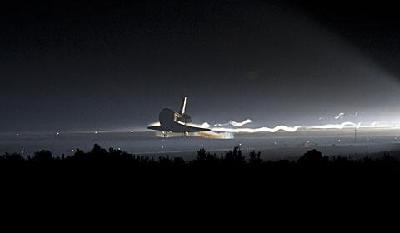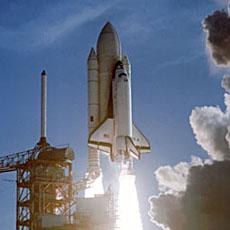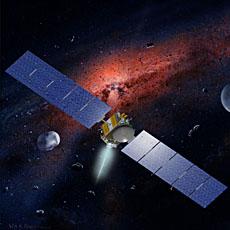
MARIO RITTER: I'm Mario Ritter.
BARBARA KLEIN: And I'm Barbara Klein with EXPLORATIONS in VOA Special English. This week, we talk about the final American space shuttle flight. Last week, space shuttle Atlantis returned to Kennedy Space Center in Florida after 13 days in space. It was the last of 135 flights for the world's first reusable space vehicle design.
But as one historic program came to an end this month, others continue to explore new worlds. The American space agency's Dawn spacecraft began circling Vesta, a member of the asteroid belt that orbits the sun.
MARIO RITTER: And we mark an anniversary. It has been one year on Neptune since that planet was discovered. Neptune, however, is the farthest planet from the sun. It is so distant, in fact, that 165 years have passed on Earth since its discovery.
(MUSIC)
Shuttle Farewell
BARBARA KLEIN: Sometimes the high technology of space exploration hides the human side of efforts to reach toward the stars. But, the space shuttle program has come to represent the success, and tragedy, of discovery at the limits of our world.
MARIO RITTER: The first shuttle flight was nearly perfect.

The National Aeronautics and Space Administration, NASA, launched Columbia from Kennedy Space Center on April 12th 1981. The nation watched on television. The shuttle launch marked the completion of goals set nearly ten years earlier.
Columbia raced into the sky and into history. Its 2,500,000moving parts made it the most complex and costly vehicle ever made. The spacecraft would repeat its first success 27 times.
But Columbia and a crew of seven astronauts were lost on its 28th mission. On February 1st, 2003, Columbia broke up as it reentered the atmosphere.
The accident sped the retirement of NASA's remaining three shuttles.
BARBARA KLEIN: Seventeen years earlier, America mourned another accident. On January 28th 1986, shuttle Challenger exploded shortly after take off.
President Ronald Reagan spoke of the lost crew.
RONALD REAGAN: "The crew of the space shuttle Challenger honored us with the manner in which they lived their lives. We will never forget them. Nor the last time we saw them this morning as they prepared for their journey and waved goodbye. And slipped the surly bonds of earth, to touch the face of God."
Both accidents showed the danger of manned space flight. But NASA studied its mistakes and worked to correct them.
After the Challenger tragedy, Endeavor was built at a cost of 1.7 billion dollars. A total of six shuttles were built. The first, Enterprise, was a test model. NASA says the program cost about 114 billion dollars over 30 years.
MARIO RITTER: Discovery holds the record for most shuttle flights with 39. It spent a total of one full year in space. Five shuttles have carried over 350 astronauts. Sally Ride became the first American woman in space in 1983. Forty-eight women have followed her.
Astronauts representing 16 countries have flown in space shuttles. The spacecraft helped build the International Space Station, repair the Hubble Space Telescope and launched many satellites and space probes.
So as Atlantis landed for the final time, Astronaut Chris Ferguson simply said "Mission complete, Houston."
CHRIS FERGUSON: "Mission complete, Houston. After serving the world for over 30 years, the space shuttle has earned its place in history, and it has come to a final stop."
(MUSIC)
Dawn to Vesta
BARBARA KLEIN: Another historic event took place on July 15th. The American space agency's Dawn spacecraft began an extended orbit around the asteroid Vesta.
Marc Rayman is chief engineer of the project.
MARC RAYMAN: "This is the first time a spacecraft has orbited a body in the main asteroid belt between Mars and Jupiter. And so to me one of the things that's so neat about this mission is we're visiting one of the last unexplored worlds in the inner Solar System."

Asteroids are pieces of rock that orbit the sun. They sometimes are called planetoids, or small planets.
Dawn was sent to the asteroid belt in search of information that may help scientists better understand how our solar system was formed. Marc Rayman says Vesta was chosen as Dawn's first stop because of its special qualities.
MARC RAYMAN: "Many people think of asteroids as sort of little chips of rock, right? That's how they're depicted in movies, maybe the size of a building or a mountain or something like that. But Vesta is not like that. This is a very big place. It's more than 330 miles, or 530 kilometers in diameter and it's got twice the surface area of California."
MARIO RITTER: Vesta is the second largest asteroid in the asteroid belt. Many scientists believe asteroids are space objects that never combined with other material to form a planet. More than 7,000 asteroids have now been identified. Most are less than 100 kilometers wide.
Marc Rayman says Vesta appears to have a layered structure, one that is similar to planets like Earth, Mars and Venus.
Scientists have repeatedly studied Vesta since its discovery more than 200 years ago. Most of what is known about it was learned through telescopic images. NASA hopes that Dawn's year long orbit around Vesta will help scientists learn more about the development of the solar system, and how asteroids and other space objects were created.
BARBARA KLEIN: NASA launched Dawn from Cape Canaveral in Florida four years ago. The spacecraft had to travel about three billion kilometers to reach Vesta. The spacecraft will move closer and closer to the asteroid until it is eventually within 120 kilometers of Vesta's surface.
After Dawn has finished collecting information, it will move on to explore its next target.
MARC RAYMAN: "We will use the tremendous capabilities of this ion propulsion system to climb out of orbit around Vesta, travel for almost another three years through the asteroid belt to dwarf planet Ceres and then go into orbit around Ceres and undertake the same kind of measurements there that we'll be doing at Vesta. And that will make Dawn the first spacecraft ever to orbit two different Solar System destinations."
Ceres was once considered the largest asteroid. It was discovered in 1801. Now it is defined as a dwarf planet.
(MUSIC)
Happy Birthday, Neptune!
MARIO RITTER: This month, Neptune completed one full orbit around the sun since its discovery 165 years ago. The big, blue, icy planet was first discovered in 1846.

Neptune remains the first, and only, planet found with math. The French mathematician Urbain Le Verrier predicted its existence while studying the unusual orbital movements of the planet Uranus. He believed a more distant planet was affecting Uranus' motion. He sent his predictions to a German astronomer at the Berlin Observatory.
Using information from Le Verrier, Johann Galle saw Neptune for the first time on September 23rd, 1846. A British astronomer named John Couch Adams had also predicted Neptune's position in space. Both are given credit for first predicting the position.
BARBARA KLEIN: Neptune is named for the Roman god of the sea. The planet's orbit lies about four billion five hundred million kilometers from the sun. That is about 30 times further away than Earth. Neptune is the most distant member of our solar system. It cannot be seen from Earth without the aid of binoculars or a telescope.
The planet's atmosphere is made up mostly of hydrogen, helium and methane. Its blue-green color is caused by methane gases in the outer atmosphere.
Most of what we know about Neptune comes from NASA's Voyager Two spacecraft. It was the first and only space probe to visit the planet in 1989.
MARIO RITTER: Thirteen known moons circle Neptune. The largest of these is called Triton. It was discovered just days after Neptune's discovery in 1846. Voyager Two discovered six of the moons during its flight around the planet. It also confirmed the existence of rings around the planet.
Neptune is one of four planets known as the gas giants. The other three are Jupiter, Saturn and Uranus. These planets are made up almost entirely of gas. They are also four to 12 times the size of earth.
Earlier this month, on July 12th, Neptune reached the same area in the sky that it occupied when it was first observed by Johann Galle. So this year, you could say, Neptune is celebrating its first birthday since being discovered.
BARBARA KLEIN: This program was written by June Simms. I'm Barbara Klein with Mario Ritter who is also our producer. Find links to NASA's space shuttle pages and also images of Neptune at voaspecialenglish.com. Join us again next week for more Explorations in VOA Special English.
asteroid: any one of the many small planets which go around the sun 小行星
Ceres: 谷神星(以罗马农业女神命名, 代表女性生儿育女)
Neptune: a planet in the solar system that is 8th in order of distance from the sun 海王星
helium: a chemical element; Helium is a very light colourless gas that does not burn, often used to fill balloons and to freeze food. 氦
methane: a gas without colour or smell, and it burns easily and is used as fuel. Natural gas consists mainly of methane. 甲烷;沼气
Space shuttle era closes with Atlantis' landing
Deep space is next aim for NASA after shuttles
Atlantis crew 'honored' to be on final shuttle mission
Space shuttle program nears an end
(来源:VOA 编辑:实习生高美)
